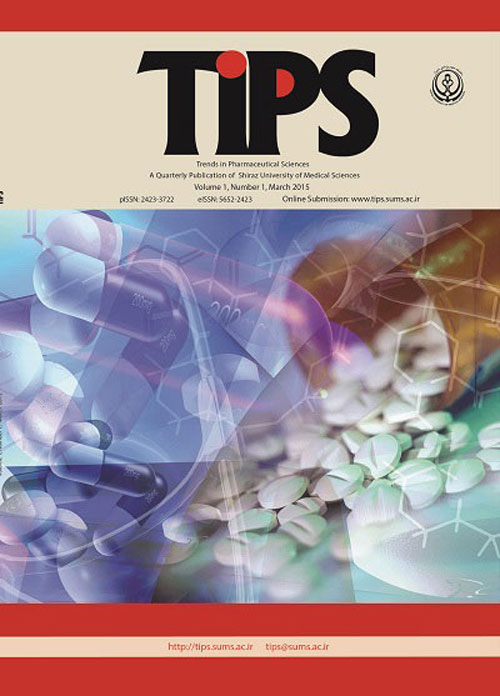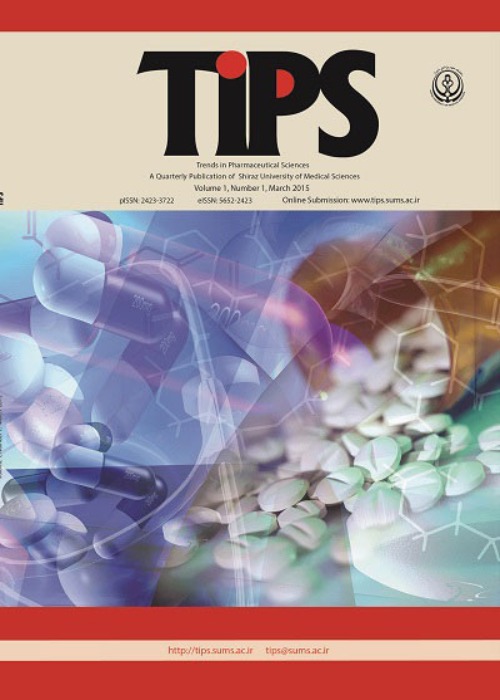فهرست مطالب

Trends in Pharmaceutical Sciences
Volume:8 Issue: 2, Jun 2022
- تاریخ انتشار: 1401/04/18
- تعداد عناوین: 8
-
Pages 65-66
Considering the growing development and wide application of nanomaterials, the necessity of safe disposal of them is increasing. Different studies have shown the accumulation of nanomaterials in ground and surface water sources, so that the ecosystem seems "to be an ultimate sink for a large portion of NPs”. Contamination of soil and water sources can result in contamination of food chain. However, we are not sure about the long-term effects on human and ecosystem health. Nanotoxicological assessments of biological consequences of wandering nanomaterials, and establishment of clear and restrict protocols for safe handling and safe disposal of nanowastes are urgent needs. It may also be necessary to specify the most efficient disposal or neutralizing method for each type of NMs among current strategies including incineration, oxidation filtration, incorporation into silica, and bioremediation by specific microorganisms. Other solution may be recovering and recycling of NMs for reuse rather than uncontrolled abandoning in the environment.
Keywords: nanowaste, nanotoxicity, nanotoxicology, nanosafety -
Pages 67-68
Vaccines have been one of the most remarkable achievements through medical history and have had a very high positive impact on human health (1). The number of prevented deaths through vaccination is estimated to be about 2-3 million per year (2). Reduction of the risk of many infectious diseases and eradication of smallpox have been the result of intensive immunization programs (3). Given that such health benefits are also translated to economic advantages, the indirect positive outcomes of immunization could be very broad. For instance, lost working days due to different diseases could partly be prevented through vaccination. Thus, despite the huge investments needed for immunization programs, they are usually assumed as cost-effective projects (4).
Keywords: Vaccine, Vaccinology, mRNA vaccine, DNA vaccine, Vaccine development, COVID-19 -
Pages 69-74
Metformin is a drug that needs improvement in its bioavailability and absorption. This can be acheived by using different drug delivery systems, making prodrugs, and changing the drug release en- vironment. Drug delivery systems are used for various reasons, for example, targeted drug delivery, pro- tecting the drugs from destruction by enzymes, and enhancing the drug's absorption, permeability, and bioavailability. According to the studies and surveys, the permeability, absorption, and bioavailability of metformin can be improved in many ways, like making prodrugs and using carriers. Prodrugs and lipid- based carriers like nanostructured lipid carriers and lipid-based polymers are the best methods that can help the medical system to reduce the dose of metformin usage in patients and reduce the side effects.
Keywords: Absorption, Bioavailability, Lipid based drug delivery systems, Metformin, Polymers, Prodrugs -
Pages 75-84
In recent years, resistance to conventional antimicrobial drugs has become a serious concern in the clinic. Hence, the discovery of novel and effective antimicrobial agents with improved properties is of great value. In this study, the antibacterial and anticandidal activities of some imidazole, benzimidazole and benztriazole derivatives (C1-C8) against several species of Gram-positive and Gram-negative bacteria, including Staphylococcus aureus, Streptococcus pyogenes, Escherichia coli and Salmonella typhi as well as one species of fungi including Candida albicans, were evaluated using Clinical & Laboratory Standards Institute (CLSI) method. Antimicrobial evaluation revealed that among the tested compounds, imidazole derivative (C5) indicated the highest activity against bacterial strains and Candida albicans. It was found that compound C5 is more potent than ampicillin against S. aureus strain (MIC =2-16 µg/mL) and possessed excellent anticandidal activity (MIC =1 µg/mL) which was comparable to Amphotericin B as the positive control. In addition, cytotoxic activity of the tested compounds was investigated using MTT assay. The results of MTT assay demonstrated that the toxicity of the tested compounds was less than 35%.
Keywords: Azoles, Antimicrobial effect, Antifungal Activity, MTT -
Pages 85-94
Edaravone is a free radical scavenger which is used as a drug for the treatment of cerebral infarction and amyotrophic lateral sclerosis. Edaravone is distributed widely in the body and its effects are not limited to the neural tissue. Many studies indicate that edaravone has some nitric oxide synthase (NOS) modulating properties. In this research we evaluated the effects of edaravone (1, 5 and 10 mg/kg) alone or in concombination with diphenyliodonium chloride (a specific endothelial NOS inhibitor) or aminoguanidine (a specific inducible NOS inhibitor) on oxidative stress, and renal tissue and function in a model of acute kidney injury induced by a single intramuscular injection of hypertonic glycerol solution. Effects of edaravone on gene expressions of eNOS and iNOS (by RT-PCR) were also investigated. Data were analyzed using one-way analysis of variance (ANOVA) followed by Tukey’s test. At the end of this study, edaravone attenuated oxidative stress and improved renal tissue damage and dysfunction. Aminoguanidine enhanced the renoprotective effects of edaravone. Edaravone showed no remarkable effect on the expression of eNOS gene but it reduced the induction of iNOS gene significantly. The results of this study showed that edaravone could protect against rhabdomyolysis-induced acute kidney injury using its antioxidant activity and inhibiting effect on iNOS gene expression.
Keywords: Edaravone, Oxidative stress, Rhabdomyolysis, Acute kidney injury, Nitric oxide -
Pages 95-106
We have explored the inhibitory capability of Thymus vulgaris compounds against ACE2 protein -the host receptor for SARS-CoV-2, papain-like and main protease of the SARS-CoV-2 through molecular simulations. The docking results showed that the compounds had a greater capability to inhibit ACE2 and papain-like protease in comparison to the main protease. The majority of compounds (61.7%) bind to the S2 active pocket of ACE2. The most powerful anticoronavirus activity is expressed in the order: Terpinolene > Thymol > Bicyclogermacrene. Pi interactions play key roles in the binding of three compounds to the active sites of ACE2 enzyme. 34 out of these 60 compounds were fitted in the PLpro active site. α-humulene followed by (+)-Spathulenol, and (-)-β-Bourbonene showed strong capacity to inhibit PLpro binding site. Except for (+)-Spathulenol which also formed H-bond with Asp165 and Tyr274 amino acids, α-humulene and (-)-β-Bourbonene conjugate with PLpro were stabilized mainly through alkyl and pi interactions. According to the Mpro docking results, 58.3% of thyme compounds could block the active site. The binding energy order was (-)-Spathulenol at highest, then Bicyclogermacrene, (+)-δ-cadinene, (+)-Spathulenol, and Viridiflorol, followed by (-)-β-Caryophyllene oxide. Cys145, His41, Met49, and Met165 are key residues in the interaction of these ligands with the enzyme binding site. The weakest interaction with all three enzymes was observed for (R)-(-)-1-Octen-3-ol and (3S)-Oct-1-en-3-ol. Based on the molecular dynamics simulation lowest conformational change was detected for ACE2 in the present of Terpinolene. (-)-Spathulenol and α-Humulene had the least and most displacement compared to its initial positions, respectively.
Keywords: COVID-19, Thyme compounds, Molecular modeling -
Pages 107-118
Acne vulgaris is a chronic multifactorial skin disease that millions of people around the world of suffering from that. Pathophysiology of acne consists of several mechanisms including hyper-seborrhea, hyperkeratinization of pilosebaceous units, increased bacterial proliferation, hyperandrogenism, alteration in sebum contents, and inflammatory processes. In this regard, consideration of the main causes of acne development and severity of acne lesions in the selection of suitable pharmacologic agents is essential. In this review, among the other factors, the role of the different lipids in pathophysiology of acne were considered. The common sources of skin lipids have been categorized into two main categories including endogenous and exogenous sources. Furthermore, the role of different factors including lipids and fatty acids, androgens, microorganisms, cosmeceuticals, and lipids oxidation and peroxides in acne vulgaris development have been summarized. In the end, the necessity of the choice of appropriate pharmacotherapy regimens and recruitment of novel drug delivery systems in acne management have been mentioned.
Keywords: Acne, Pathophysiology, Lipids, Microorganisms, Androgens, Cosmeceuticals -
Pages 119-126
Since the beginning of detection of severe acute respiratory syndrome coronavirus 2 (SARS-CoV-2) in 2019, many genetic evolutions of this virus have been reported. The most recent variant that caused the fourth wave of Covid-19 infection worldwide, Omicron, has shown various mutations at its receptor binding domain therefore inducing changes in behavior compared to previous variants. According to published data, major genetic mutations, differences in clinical severity and also resistance to prevention and treatment strategies have been observed. Lower rates of disease severity, hospital and intensive care unit admissions, younger age of contamination with progression to severe disease, resistance to 2 dose vaccination, risk of re-infection and resistance to monoclonal antibodies have been some of the many differences in the recent variant of concern. In the following article some considerations and modifications of the Omicron variant with regard to its general characteristics and treatment will be discussed.
Keywords: Omicron, SARS-CoV-2, Sever acute respiratory syndrome, Variant of concern


